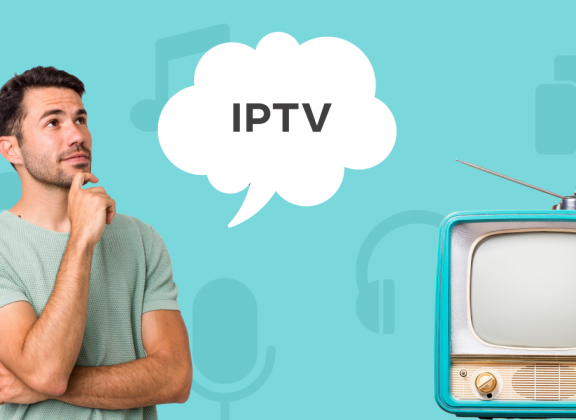The convenience and flexibility of IPTV (Internet Protocol Television) continues to attract more viewers. However, many converts also want to know how to watch IPTV on CRT TV or on a non-smart device with no advanced features. Below, we’ll explore various approaches for setting up IPTV on old TV, so you can enjoy digital content on your older display.
IPTV Box for Traditional TV
The easiest and most common solution is purchasing an IPTV box for traditional TV – essentially a set-top box that transforms a standard television into a media hub. With this device, you can access on-demand videos, streaming channels, and more. To connect IPTV to non-smart TV, follow these steps:
Link the box to your network. Usually, this involves a stable Wi-Fi or Ethernet connection. A reliable internet link is vital for smooth streaming.
Attach the device to your TV. If there’s an HDMI port, just use an HDMI cable for both audio and video. If the TV is older (no HDMI), you’ll need an IPTV with HDMI converter such as HDMI-to-AV (RCA).
Install and configure the software. Most set-top boxes run on Android or a similar platform. They often come with apps like Smart IPTV or OTTplayer, and you can also download other IPTV apps from an app store.
Advantages
- Straightforward setup
- Supports various services and apps
- Often receives firmware updates
Disadvantages
- May need adapter compatibility if no HDMI port is available
HDMI Adapter or Multimedia Player
If your television features an HDMI input—or if you’ve bought an adapter for older analog TV connectors—you can watch IPTV using compact streaming devices for old TVs, such as Google Chromecast, Amazon Fire TV Stick, or Xiaomi Mi TV Stick:
Plug the device into the TV. Connect it to the HDMI input (or use an adapter). Many devices need additional power from a USB port or outlet.
Set up the services. Access the built-in app store to download IPTV apps that fit your needs, then add your playlist or IPTV provider data.
Control via remote or phone. Some sticks can be controlled using a smartphone, while others include a small remote.
Pros
- Compact design, easy to relocate between multiple televisions
- Often includes extra apps: YouTube, Netflix, etc.
Cons
- Not every model works well with very outdated TVs
- Possible limitations related to functionality or apps
Using a PC or Laptop as a Source
Another method of IPTV setup for older television is linking your TV to a computer or laptop that already runs IPTV. This might suit those who prefer not to purchase extra hardware. Follow these steps:
Configure IPTV on your PC. Install a media player application for IPTV playlists or try your IPTV provider’s web-based platform. Load your playlist and confirm stable playback.
Connect the TV. Use an HDMI cable if the TV has an HDMI port. If only RCA is available, get an adapter to handle connecting IPTV via AV cables. On some laptops, there’s only a VGA output, meaning you’ll need a VGA-to-AV (or VGA-to-HDMI) converter.
Enjoy your viewing. Once the player or browser is correctly set up, your TV should mirror the content. If your adapter supports audio, the same cable carries sound.
Advantages
- No extra hardware costs if a PC or laptop is already on hand
- Full control over functionality from the computer
Disadvantages
- Less convenient arrangement (an additional device is needed)
- More cables and adapters required
- Consumes extra power and keeps the computer running
Using a Smartphone/Tablet as a Bridge
An alternative option for implementing IPTV solutions for outdated TVs is to cast the screen from a mobile device to an older TV:
Install IPTV on your phone. Download an app from the store (e.g., IPTV Smarters, TiviMate), add your playlist, and test its performance.
Connect the TV. If the phone supports wired output, use an MHL or SlimPort cable. Otherwise, rely on wireless protocols like Miracast, AirPlay, or Google Cast. Extremely old TVs may require specialized adapters.
Mirror your screen. On your phone, choose “Screen Mirroring,” “Cast,” etc. The TV should detect and display the stream.
Advantages
- No need to invest in new hardware if you already have a computer
- Convenient for quickly sharing smartphone content
Disadvantages
- Controls are more complicated (everything on your phone)
- Can rapidly drain the phone’s battery
- Might need additional adapters for very old TVs
Which Option Is Best?
If your TV lacks an HDMI port, the easiest route is typically buying a set-top box with RCA outputs or using a PC as your source. If you have the possibility of an HDMI connection—or an appropriate adapter—try using a modern media stick or other streaming devices for old TVs, giving you IPTV and a range of online apps.
It’s crucial to remember that picture quality and reliability depend much more on your internet speed than on your TV’s age. A higher bandwidth means fewer lags and buffering. Also, pick a dependable IPTV provider that offers timely playlist updates and adequate support.
Currently, there are multiple routes to using IPTV on analog TV. Selecting the right one depends on your television’s features, the equipment you own, your budget, and your personal needs—whether you want advanced streaming features or just basic channels.
By carefully evaluating the options, you can transform an older display into a fully functional media center, reaping the benefits of digital TV.
